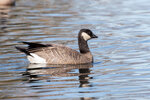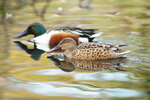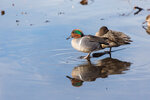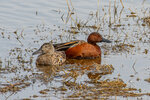



My son, Aaron, and I went to the Billy Frank, Jr. Nisqually National Wildlife Refuge on Earth Day. Here is our report on what we saw and heard. If you go to the refuge in the next several weeks, you can expect to have similar observations.
We arrived fairly late, about 5 p.m., and were greeted with light rain, which did not seem to bother the birds at all. And it didn’t bother us too much, either. The defining characteristic of Earth is water, so walking in light rain is an entirely appropriate Earth Day celebration.
At the refuge, all the precipitation we’ve received this winter and spring has resulted in dramatic changes. All the wetlands are now full and the rain has exposed dirt under the interior boardwalks, leaving shallow water, with frogs peeking out along its edges. They’re a nice observation target for children.
The birds that made the greatest impression on us were the waterfowl. Many species breed in the far north, and they are staging for their spring migration now. There was a huge flock of Cackling Geese. At about 7 p.m. a flock of maybe 10,000 came flying in, loudly vocalizing. These geese look like small Canada Geese, but when you get a good look, you can easily see their much shorter necks and overall smaller body proportions (and their vocalizing is a chatty cackle, not a honk). They breed in the far northwest of Alaska and also in the Siberian Arctic. They are grazing on all our fresh green grass before undertaking the rest of their long journey.
Of all the ducks now common at the refuge, the most stunning in my view is the Northern Shoveler. The males’ sides are bright cinnamon, contrasting with their white chests and rumps. Their heads are vivid green. The females are not boldly colored, but they are now pairing up so that the brown bird next to the male is a female shoveler. Their common name, shoveler, is because they have a prominent shovel-shaped bill.
Another very common duck at the refuge now is the Green-winged Teal. They are also pairing up, but also are seen in scattered small flocks. They like to hang out along the muddy edges of the tidal flats. We saw them near the road as we entered the refuge and also multiple locations along the outer trail and tidal boardwalk. These are small, stubby ducks and are most easily identified by the males having a bold vertical white stripe on the side and a green streak behind the eye. Females are a drab, mottled brown, but you don’t have to worry about identifying them since they are found with males at this time of year.
About the time Green-winged Teals leave, they are replaced with another teal species, the Cinnamon Teal. Males of this species are a rich cinnamon color (females are a dull mottled brown) and, before the grass gets too high, they should be easily seen at the refuge. (Don’t get too concerned about the dull colors of the duck females. That dull color hides them from predators while they are on their nests brooding eggs)
These species, and others, will soon depart, as their breeding areas in the interior of North America and the Arctic become freed from the grip of winter. The fact that our Pacific Northwest warms up more quickly than the interior allows waterfowl species to visit our refuges and habitat areas to fatten up. They still have quite a way to go before breeding and refueling here is vital for them.
As Aaron and I were leaving the refuge at about 8 p.m. (our car feeling lonely in a parking lot that, hours earlier, had been packed), we were talking about beaver dams and ponds, and how we never seem to actually see beavers. Just a few minutes later, we heard loud splashing on the pond near the refuge headquarters. It was a large beaver slapping its tail on the water. Beavers sometimes slap their tails as they dive, which may serve as a warning to others. But to us, it just seemed like a beaver having a good time and creating a fitting end to our Earth Day.
Reminders: Next weekend (May 5-7) is the Grays Harbor Shorebird Festival. This weekend has the best daytime tides for shorebird viewing, and there could be tens of thousands of them. Quite a sight to see these huge flocks as they fly over the harbor.
Dawn Chorus – Our neighborhood birds are singing, and more species are arriving every week. The chorus now starts at about 5:30 a.m. with multiple robins and other species, loudly greeting the dawn. If you are up and about, it’s worth a listen. If you’re driving to work, stop by a wooded area and give it a listen. If you’re near a wet area, multiple Chorus Frogs will be part of this spring entertainment.
George Walter is environmental program manager at the Nisqually Indian Tribe’s natural resources department; he also has a 40+ year interest in bird watching. He may be reached at george@theJOLTnews.com
Photos for this column are generally provided by Liam Hutcheson, a 15-year-old Olympia area birder and avid photographer.
1 comment on this item Please log in to comment by clicking here
HarveysMom
Thanks, George. And beautiful photos.
Friday, April 28, 2023 Report this